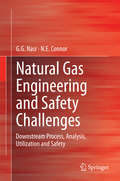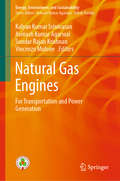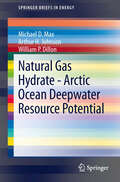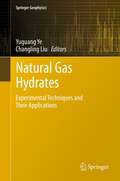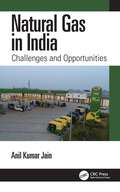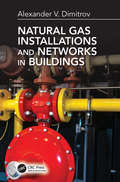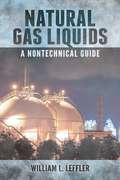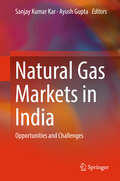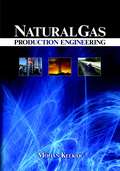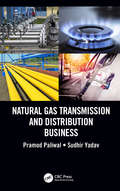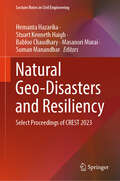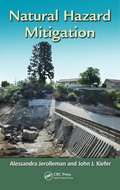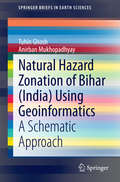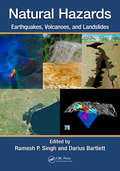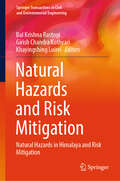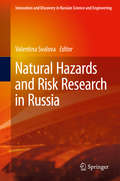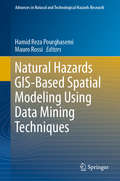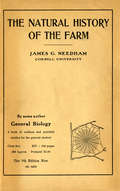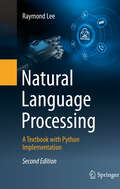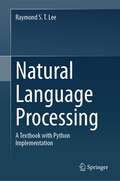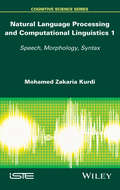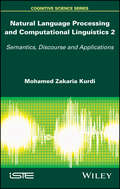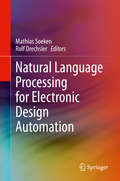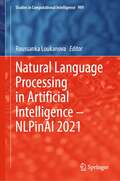- Table View
- List View
Natural Gas Engineering and Safety Challenges
by G. G. Nasr N. E. ConnorProviding a critical and extensive compilation of the downstream processes of natural gas that involve the principle of gas processing , transmission and distribution, gas flow and network analysis, instrumentation and measurement systems and its utilisation, this book also serves to enrich readers understanding of the business and management aspects of natural gas and highlights some of the recent research and innovations in the field. Featuring extensive coverage of the design and pipeline failures and safety challenges in terms of fire and explosions relating to the downstream of natural gas technology, the book covers the needs of practising engineers from different disciplines, who may include project and operations managers, planning and design engineers as well as undergraduate and postgraduate students in the field of gas, petroleum and chemical engineering. This book also includes several case studies to illustrate the analysis of the downstream process in the gas and oil industry. Of interest to researchers is the field of flame and mitigation of explosion: the fundamental processes involved are also discussed, including outlines of contemporary and possible future research and challenges in the different fields.
Natural Gas Engines: For Transportation And Power Generation (Energy, Environment, and Sustainability)
by Kalyan Kumar Srinivasan Avinash Kumar Agarwal Sundar Rajan Krishnan Vincenzo MuloneThis book covers the various advanced reciprocating combustion engine technologies that utilize natural gas and alternative fuels for transportation and power generation applications. It is divided into three major sections consisting of both fundamental and applied technologies to identify (but not limited to) clean, high-efficiency opportunities with natural gas fueling that have been developed through experimental protocols, numerical and high-performance computational simulations, and zero-dimensional, multizone combustion simulations. Particular emphasis is placed on statutes to monitor fine particulate emissions from tailpipe of engines operating on natural gas and alternative fuels.
Natural Gas Hydrate - Arctic Ocean Deepwater Resource Potential
by Michael D. Max Arthur H. Johnson William P. DillonThe book is an up-to-date basic reference for natural gas hydrate (NGH) in the Arctic Ocean. Geographical, geological, environmental, energy, new technology, and regulatory matters are discussed. The book should be of interest to general readers and scientists and students as well as industry and government agencies concerned with energy and ocean management. NGH is a solid crystalline material that compresses gas by about a factor of about 164 during crystallization from natural gas (mainly methane) - rich pore waters over time. NGH displaces water and may form large concentrations in sediment pore space. Its formation introduces changes in the geotechnical character of host sediment that allows it to be distinguished by seismic and electric exploration methods. The chemical reaction that forms NGH from gas and water molecules is highly reversible, which allows controlled conversion of the NGH to its constituent gas and water. This can be achieved rapidly by one of a number of processes including heating, depressurization, inhibitor injection, dissolution, and molecular replacement. The produced gas has the potential to make NGH a valuable unconventional natural gas resource, and perhaps the largest on earth. Estimates for NGH distribution, concentration, economic targets, and volumes in the Arctic Ocean have been carried out by restricting the economic target to deepwater turbidite sands, which are also sediment hosts for more deeply buried conventional hydrocarbon deposits. Resource base estimates are based on NGH petroleum system analysis approach using industry-standard parameters along with analogs from three relatively well known examples (Nankai-Japan, Gulf of Mexico-United States, and Arctic permafrost hydrate). Drilling data has substantiated new geotechnical-level seismic analysis techniques for estimating not just the presence of NGH but prospect volumes. In addition to a volumetric estimate for NGH having economic potential, a sedimentary depositional model is proposed to aid exploration in the five different regions around the deep central Arctic Ocean basin. Related topics are also discussed. Transport and logistics for NGH may also be applicable for stranded conventional gas and oil deposits. Arising from a discussion of new technology and methodologies that could be applied to developing NGH, suggestions are made for the lowering of exploration and capital expenses that could make NGH competitive on a produced cost basis. The basis for the extraordinarily low environmental risk for exploration and production of NGH is discussed, especially with respect to the environmentally fragile Arctic region. It is suggested that because of the low environmental risk, special regulations could be written that would provide a framework for very low cost and safe development.
Natural Gas Hydrates
by Changling Liu Yuguang Ye"Natural Gas Hydrates: Experimental Techniques and Their Applications" attempts to broadly integrate the most recent knowledge in the fields of hydrate experimental techniques in the laboratory. The book examines various experimental techniques in order to provide useful parameters for gas hydrate exploration and exploitation. It provides experimental techniques for gas hydrates, including the detection techniques, the thermo-physical properties, permeability and mechanical properties, geochemical abnormalities, stability and dissociation kinetics, exploitation conditions, as well as modern measurement technologies etc. This book will be of interest to experimental scientists who engage in gas hydrate experiments in the laboratory, and is also intended as a reference work for students concerned with gas hydrate research. Yuguang Ye is a distinguished professor of Experimental Geology at Qingdao Institute of Marine Geology, China Geological Survey, China. Professor Changling Liu works at the Qingdao Institute of Marine Geology, China Geological Survey, China.
Natural Gas in India: Challenges and Opportunities
by Anil Kumar JainThis book provides a detailed discussion on India’s energy mix including descriptive use of the Shannon Wiener diversity index for numerically comparing India’s diversity in energy supply with other leading energy-consuming countries. The likely supply scenarios of both domestic and imported gas, and price competitiveness with competing fuels in differing consuming sectors, have also been presented. Overall, it covers energy systems, a comparison of the Indian natural gas economy with other countries and a scenario-based analysis of gas demand in India in 2030. Features: Presents a well-structured and robust thesis on the challenges and opportunities for natural gas in India’s energy future. Draws upon key insights, lessons and ways forward from the gas sector reform process. Addresses the energy transition scenario towards net zero. Includes comparative analysis of India’s diversity of commercial primary energy supply. Uses granular data and visual representations of the same to convey the key arguments. This book is aimed at oil and gas industry stakeholders including professionals, business executives, techno-managerial personnel and students in chemical engineering.
Natural Gas Installations and Networks in Buildings
by Alexander V. DimitrovThis book covers theoretical foundations of the Natural Gas (NG) installations and networks as a part of building logistic system, illustrated with digital examples. It describes the NG oxidation phenomena and appropriate energy converting devices used in the building’s energy centres and basic sizing principals of the related pipe networks. Further, it covers usage of NG devices including system for thermal comfort control, building ventilation, indoor air quality, visual comfort, food preparation and conservation, and hygiene maintenance system. A special attention is given to applications of the NG technological equipment, using gas-driven heat pumps, micro heat and power systems. Aimed at professionals and graduate students in the areas of HVAC, Plumbing, Architecture, Electricians, this book: Presents complex, innovative and systematical approach to NG installations in buildings. Reviews efficient and environmentally sustainable dementalization approach to building energy supply, using NGmHps v/s central energy supply systems. Explains pre-designating calculations of the gas piping networks. Illustrates structures, principals of operation and building project implementations of the modern GN energy converters and transformers as fuel cells (SOFC, MOFC, PEFC) and NG driven heat pumps. Discusses calculation methods derived from professional case studies.
Natural Gas Liquids: A Nontechnical Guide
by William L. LefflerWritten in accessible language, Natural Gas Liquids: A Nontechnical Guide is a comprehensive overview of NGLs from production in the oil patch to consumption in the fuels and petrochemicals industries. Author William Leffler covers everything from gas plants, logistics, storage, refinery operations, and the chemistry necessary to have a full understanding of the whole value chain. With chapter highlights and exercises, and many photos, illustrations and graphs, this is the perfect resource for anyone seeking a better understanding of the world of natural gas liquids.
Natural Gas Markets in India
by Sanjay Kumar Kar Ayush GuptaThis book shares the latest market developments and advances in natural gas demand, supply, transmission, distribution, and consumption, with a special emphasis on the Indian context. Chapters are written by researchers and industry professionals working in the field of natural gas and energy to provide deeper insights into natural gas market structure, market development, business opportunities and market growth. Topics covered include, natural gas demand-supply, exploration and production policy, downstream regulatory developments, city gas distribution, pipeline, pricing, and taxation policies impacting natural gas market developments in India. The book will be useful to researchers, professionals, and policy makers working in the area of natural gas and related fields.
Natural Gas Production Engineering
by Mohan KelkarIn this important new book, Mohan Kelkar, a respected author and professor, presents the quintessential guide for gas engineers, emphasizing the practical aspects of natural gas production. Readers will learn to incorporate cutting-edge research in estimating reserves, evaluating the performance of fractured wells, processing gas, and material balance analysis; learn to evaluate future performance of gas reservoirs; learn to improve the performance of gas wells; and more.
Natural Gas Transmission and Distribution Business
by Pramod Paliwal Sudhir YadavThe natural gas business consists of two major aspects, sourcing and transportation, and distribution has been a growing area of interest to industry, government and academia. With the emphasis on promoting natural gas sector, there is an increasing need to have a well documented book that deals with the business issues, particularly the transportation and distribution of this sector, specifically aimed at petroleum engineers and professionals. This book fills this gap to provide structured material that deals with managerial and regulatory aspects with an applied technical perspective wherever needed.
Natural Geo-Disasters and Resiliency: Select Proceedings of CREST 2023 (Lecture Notes in Civil Engineering #445)
by Hemanta Hazarika Stuart Kenneth Haigh Babloo Chaudhary Masanori Murai Suman ManandharThis book presents select proceedings of the 2nd International Conference on Construction Resources for Environmentally Sustainable Technologies (CREST 2023), and focuses on sustainability, promotion of new ideas and innovations in design, construction and maintenance of geotechnical structures with the aim of contributing towards climate change adaptation and disaster resiliency to meet the UN Sustainable Development Goals (SDGs). It presents latest research, information, technological advancement, practical challenges encountered, and solutions adopted in the field of geotechnical engineering for sustainable infrastructure towards climate change adaptation. This volume will be of interest to those in academia and industry alike.
Natural Hazard Mitigation
by Alessandra Jerolleman John J. KieferOne of the four core phases of emergency management, hazard mitigation is essential for reducing disaster effects on human populations and making communities more resilient to the impacts of hazards. Presenting an up-to-date look at the changing nature of disasters, Natural Hazard Mitigation offers practical guidance on the implementation and selection of hazard mitigation programs and projects. Based on real-world applications, the book includes case studies that present a thorough explanation of the various issues involved. The contributors describe the value and potential of mitigation efforts and explain how to convince public officials and communities of that value. They also discuss how to better involve the community and uniquely tailor solutions to regional and local situations. The book begins with an overview of the history of hazard mitigation with a focus on the Disaster Mitigation Act of 2000. It examines where hazard mitigation fits into emergency management and addresses some of the challenges that can arise in navigating the various intergovernmental relationships involved in hazard mitigation. The remaining chapters explore: Public-private partnerships for hazard mitigation at the local level The role currently played by the private sector and how communities can best make use of contractors How to maximize the use of the National Flood Insurance Program and the Community Ratings System Risk communications as a key component of encouraging hazard mitigation Legal issues relevant to hazard mitigation Ways to actively engage the community and how to advocate for hazard mitigation policy How state and local governments can promote and fund mitigation without utilizing federal dollars The challenges associated with volunteers and how to best make use of this resource The area analysis as an innovative means of addressing flood risk at the block or neighborhood level The book includes learning objectives, key terms, and end-of-chapter questions to enhance comprehension. It concludes with a discussion of tools that local practitioners can use and provides an appendix with additional links and resources. This volume is an essential reference for both students and professionals in the ongoing effort to better prepare communities against the effects of natural hazards.
Natural Hazard Zonation of Bihar (India) Using Geoinformatics
by Tuhin Ghosh Anirban MukhopadhyayWith increased climate variability, aggravated natural hazards in the form of extreme events are affecting the lives and livelihoods of many people. This work serves as a basis for formulating a 'preparedness plan' to ensure the effective policy formulation for planned development. Increased demand and competition with a high degree of variability have forced people to struggle in order to prosper. Good governance and innovative policy formulation are necessary to create a resilient society. This may promote a paradigm shift in the mindset on and perceptions of natural hazards and their impacts on development and growth. This new perspective will make people more concerned about minimizing the loss of life, property, and environmental damage and directly safeguard the development process. This book presents a detailed methodological approach to monitoring meteorological, hydrological, and climate change aspects to help resolve issues related to our environment, resources, and economies in the changing climate situation.
Natural Hazards: Earthquakes, Volcanoes, and Landslides
by Ramesh Singh Darius BartlettOver the years, the interactions between land, ocean, biosphere and atmosphere have increased, mainly due to population growth and anthropogenic activities, which have impacted the climate and weather conditions at local, regional and global scales. Thus, natural hazards related to climate changes have significantly impacted human life and health on different spatio-temporal scales and with socioeconomic bearings. To monitor and analyze natural hazards, satellite data have been widely used in recent years by many developed and developing countries. In an effort to better understand and characterize the various underlying processes influencing natural hazards, and to carry out related impact assessments, Natural Hazards: Earthquakes, Volcanoes, and Landslides, presents a synthesis of what leading scientists and other professionals know about the impacts and the challenges when coping with climate change. Combining reviews of theories and methods with analysis of case studies, the book gives readers research information and analyses on satellite geophysical data, radar imaging and integrated approaches. It focuses also on dust storms, coastal subsidence and remote sensing mapping. Some case studies explore the roles of remote sensing related to landslides and volcanoes. Overall, improved understanding of the processes leading to these hazardous events will help scientists predict their occurrence. Features Provides information on the physics and physical processes of natural hazards, their monitoring and the mapping of damages associated with these hazards Explains how natural hazards are strongly associated with coupling between land–ocean–atmosphere Includes a comprehensive overview of the role of remote sensing in natural hazards worldwide Examines risk assessment in urban areas through numerical modelling and geoinformation technologies Demonstrates how data analysis can be used to aid in prediction and management of natural hazards
Natural Hazards and Risk Mitigation: Natural Hazards in Himalaya and Risk Mitigation (Springer Transactions in Civil and Environmental Engineering)
by Bal Krishna Rastogi Girish Chandra Kothyari Khayingshing LuireiThe book is on latest investigations of natural hazards like earthquakes, landslides, and glacial hazards carried out in last few years. Review papers are on the crustal structure of Himalaya based on latest studies through tomography and receiver transfer function. The seismotectonic models inferred from detailed modelling are also presented. Papers are on shallow soil/sediment structures inferred from passive seismic data, and also on estimation of strong ground motion. Several papers are on landslides and slope stability and two papers on glacial Hazards. A paper suggests multidisciplinary investigations for landslide and glacial hazards. Most of the papers are on investigations in J&K and western Himalaya which have come out for the first time. The results will be useful for planning risk mitigation. One paper is on safety of heritage structures of Ahmedabad UNESCO Heritage Site. Four papers give estimates of active deformation using PSINsar data in different regions. Two papers are on precursors. One review paper relates GPS results with earthquakes. Velocities of inferred movements in different parts of Himalaya are interpreted as partitions of active zones. This may preclude occurrence of mega earthquakes in Himalaya. Some papers show maps of VS30. One paper illustrates liquefaction potential at a dam site. Some papers outlay strategies for multidisciplinary research for risk mitigation of multi hazards. This book can serve as a valuable resource for researchers and professionals interested in the field of natural hazards.
Natural Hazards and Risk Research in Russia (Innovation and Discovery in Russian Science and Engineering)
by Valentina SvalovaThis book presents natural hazards and risk--one of the fastest-growing and most relevant fields of pure and applied research within geosciences and environmental engineering—from a multi-disciplinary perspective. It examines principles, concepts, and paradigms derived from diverse research studies, and explains operational terms, materials, tools, techniques, and methods used in practice. Collecting the expertise of more than 60 scientists and expert practitioners from across Russia, this authoritative volume is ideal for the diverse range of researchers and professionals concerned with the interaction of natural hazards and the built environment.Maximizes reader understanding of natural hazards research and risk analysis in Russia;Explains relevance and application of primary tools and practices in risk study;Clarifies similarities and differences in fundamental concepts and principles across the discipline;Directs geologists, engineers, architects, planners, teachers, students, and others to authoritative sources.
Natural Hazards GIS-Based Spatial Modeling Using Data Mining Techniques (Advances In Natural And Technological Hazards Research #48)
by Hamid Reza Pourghasemi Mauro RossiThis edited volume assesses capabilities of data mining algorithms for spatial modeling of natural hazards in different countries based on a collection of essays written by experts in the field. The book is organized on different hazards including landslides, flood, forest fire, land subsidence, earthquake, and gully erosion. Chapters were peer-reviewed by recognized scholars in the field of natural hazards research. Each chapter provides an overview on the topic, methods applied, and discusses examples used. The concepts and methods are explained at a level that allows undergraduates to understand and other readers learn through examples. This edited volume is shaped and structured to provide the reader with a comprehensive overview of all covered topics. It serves as a reference for researchers from different fields including land surveying, remote sensing, cartography, GIS, geophysics, geology, natural resources, and geography. It also serves as a guide for researchers, students, organizations, and decision makers active in land use planning and hazard management.
Natural History of the Farm: A Guide to the Practical Study of the Sources of Our Living in Wild Nature
by James G. NeedhamThis is a guide to the practical study of the sources in wild nature of our living. It contains a series of study outlines for the entire year, and deals with both the plants and animals of the farm-the things that men have chosen to deal with as a means of livelihood and of personal satisfaction in all ages.
Natural Inflammatory Molecules in Fruits and Vegetables (SpringerBriefs in Molecular Science)
by Ramesh Kumar Sharma Maria Anna Coniglio Pasqualina LaganàThis book explores the role that some natural molecules found in fruits and vegetables, and their derivatives, play in excessive oxidation reactions that lead to inflammation in the human body. Particular attention is given to oxidation during food processing, especially when it comes to high-energy foods (derived from cereals) with notable amounts of oxidation-sensible lipids and protein chains. This book critically assesses the increased consumption of high-energy foods from a public health perspective. In addition, it provides an overview of the research into the unsaturated fatty acids and polypeptides responsible for nitric oxide production and elucidates the analytical identification of natural inflammatory molecules in fruits and vegetables. The book appeals not only to academic researchers and professors interested in public hygiene and food safety; medicine; food production; HACCP studies, but also to public health practitioners, and regulatory specialists and consultants.
Natural Language Processing: A Textbook with Python Implementation
by Raymond LeeThis textbook provides a contemporary and comprehensive overview of Natural Language Processing (NLP), covering fundamental concepts, core algorithms, and key applications such as AI chatbots, Large Language Models and Generative AI. Additionally, it includes seven step-by-step NLP workshops, totaling 14 hours, that offer hands-on practice with essential Python tools, including NLTK, spaCy, TensorFlow, Keras, Transformers, and BERT. The objective of this book is to provide readers with a fundamental grasp of NLP and its core technologies, and to enable them to build their own NLP applications (e.g. Chatbot systems) using Python-based NLP tools. It is both a textbook and NLP tool-book intended for the following readers: undergraduate students from various disciplines who want to learn NLP; lecturers and tutors who want to teach courses or tutorials for undergraduate/graduate students on NLP and related AI topics; and readers with various backgrounds who want to learn NLP, and more importantly, to build workable NLP applications after completing its 14 hours of Python-based workshops.
Natural Language Processing: A Textbook with Python Implementation
by Raymond S. LeeThis textbook presents an up-to-date and comprehensive overview of Natural Language Processing (NLP), from basic concepts to core algorithms and key applications. Further, it contains seven step-by-step NLP workshops (total length: 14 hours) offering hands-on practice with essential Python tools like NLTK, spaCy, TensorFlow Kera, Transformer and BERT.The objective of this book is to provide readers with a fundamental grasp of NLP and its core technologies, and to enable them to build their own NLP applications (e.g. Chatbot systems) using Python-based NLP tools. It is both a textbook and NLP tool-book intended for the following readers: undergraduate students from various disciplines who want to learn NLP; lecturers and tutors who want to teach courses or tutorials for undergraduate/graduate students on NLP and related AI topics; and readers with various backgrounds who want to learn NLP, and more importantly, to build workable NLP applications after completing its 14 hours of Python-based workshops.
Natural Language Processing and Computational Linguistics: Speech, Morphology and Syntax
by Mohamed Zakaria KurdiThis book aims to develop a panoramic review of both classical and modern works in the field of NLP. It offers a unified view of fields often considered divergent such as speech processing, computational linguistics, natural language processing and knowledge engineering. He also wants to deeply interdisciplinary considering, as possible, equal linguistic and cognitive models, algorithms and computer applications. He thus expressed the opinion, repeatedly certified in NLP and elsewhere, that the best results can only be the fruit of marriage a good theory with a well-designed empirical approach.
Natural Language Processing and Computational Linguistics 2: Semantics, Discourse and Applications
by Mohamed Zakaria KurdiNatural Language Processing (NLP) is a scientific discipline which is found at the intersection of fields such as Artificial Intelligence, Linguistics, and Cognitive Psychology. This book presents in four chapters the state of the art and fundamental concepts of key NLP areas. Are presented in the first chapter the fundamental concepts in lexical semantics, lexical databases, knowledge representation paradigms, and ontologies. The second chapter is about combinatorial and formal semantics. Discourse and text representation as well as automatic discourse segmentation and interpretation, and anaphora resolution are the subject of the third chapter. Finally, in the fourth chapter, I will cover some aspects of large scale applications of NLP such as software architecture and their relations to cognitive models of NLP as well as the evaluation paradigms of NLP software. Furthermore, I will present in this chapter the main NLP applications such as Machine Translation (MT), Information Retrieval (IR), as well as Big Data and Information Extraction such as event extraction, sentiment analysis and opinion mining.
Natural Language Processing for Electronic Design Automation
by Mathias Soeken Rolf DrechslerThis book describes approaches for integrating more automation to the early stages of EDA design flows. Readers will learn how natural language processing techniques can be utilized during early design stages, in order to automate the requirements engineering process and the translation of natural language specifications into formal descriptions. This book brings together leading experts to explain the state-of-the-art in natural language processing, enabling designers to integrate these techniques into algorithms, through existing frameworks.
Natural Language Processing in Artificial Intelligence — NLPinAI 2021 (Studies in Computational Intelligence #999)
by Roussanka LoukanovaThe book covers theoretical work, approaches, applications, and techniques for computational models of information, language, and reasoning. Computational and technological developments that incorporate natural language are proliferating. Adequate coverage of natural language processing in artificial intelligence encounters problems on developments of specialized computational approaches and algorithms. Many difficulties are due to ambiguities in natural language and dependency of interpretations on contexts and agents. Classical approaches proceed with relevant updates, and new developments emerge in theories of formal and natural languages, computational models of information and reasoning, and related computerized applications. Its focus is on computational processing of human language and relevant medium languages, which can be theoretically formal, or for programming and specification of computational systems. The goal is to promote intelligent natural language processing, along with models of computation, language, reasoning, and other cognitive processes.
